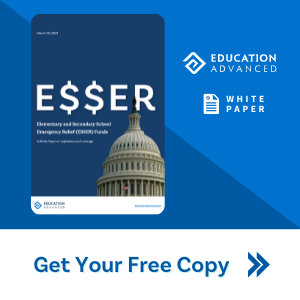On Thursday, March 11, 2021, the first anniversary of the pandemic declaration, H.R. 1319, the “American Rescue Plan Act (ARPA) of 2021,” was signed and became Law 117-2. The ARPA, a $1.9 trillion plan, included an even larger relief package for ESSER III than ESSER I and ESSER II combined, providing $123 billion for schools to tackle learning loss and prepare to reopen in the fall. These funds provide critical assistance to help schools and districts maintain a high-quality learning environment, continue the establishment of innovative learning methods, and combat COVID-19 related learning loss.
>>> Read the full whitepaper here.
The Purpose of ESSER
The Elementary and Secondary School Emergency Relief Fund (ESSER) was established as part of the Education Stabilization Fund to provide State educational agencies (SEAs) with grant awards for local education agencies (LEAs) to address the influence of COVID-19. ESSER I and II directed States to disburse 90% of the allocation to LEAs utilizing the Title I formulas. Although awarded using the same procedure, ESSER funds are not part of the Title I A funds and must be granted and tracked separately. States were allowed to reserve ½ of 1 percent of the total allocation for administrative purposes and not more than 10% for COVID-19 related emergency needs.
The distribution of ESSER III funds to districts will follow the Title I A plan, with 90% of the funds awarded in grants. However, the remaining 10% allotted to the state requires a more specific allocation formula. Of the SEA funds, 5% must provide “evidence-based activities” to address unfinished student learning, for example, state-funded summer school programs. Also, 1% must implement a summer enrichment program to address students’ academic, social, and emotional needs. Another 1% should implement evidence-based afterschool programs. The SEA allotment includes an administrative allowance of no more than 0.5%, with the remaining 2.5% of the funds reserved for other COVID-19 related emergencies. New programs should target the needs of students disproportionately affected by the pandemic, including racial and ethnic minorities, economically disadvantaged students, students with disabilities, English learners, students who are migratory or experiencing homelessness, and students in foster care. The ARPR also provides funds directly for non-public schools. Therefore, public schools are not required to provide funding assistance to non-public entities from the ESSER III distribution for the LEA.
Allowable Uses and Allocations
In 1965 with the passage of the Elementary and Secondary Education Act, the Title I provision created a program for distributing funds to schools and school districts with a high percentage of students from low-income families. Title I intends to develop programs that properly support children with intervention programs aimed to improve student outcomes and retention rates, among other projects. CARES Act funds must be obligated or returned by approximately May 30, 2020. The CRRSA funds must be obligated by September 30, 2022, and the ARPA funds must be obligated by September 30, 2023.
>>> Find allowable uses of ESSER funds and approximate amounts allocated to each state from each appropriation act here.
Meeting the Greatest Needs
Over the past year, there have been nearly 1,000 scholarly articles written about the impact and disruption that COVID-19 has had on student learning. Schools around the country have experienced changes in the environment and classroom dynamic to maintain the health and well-being of students, faculty, and staff. ESSER funds provide critical assistance to help schools and districts facilitate a successful return to school, overcome higher than normal staff turnover, address unfinished learning, and monitor student academic progress.
It will take years of research to understand the overall influence of COVID-19 fully. While it is essential to address the immediate needs of returning students to classrooms, the other aspect to consider in using these one-time federal dollars is how to leverage the funding towards long-term goals in creating instructional systems that will serve beyond today. Investing in educational technology solutions that provide logistical support for instructional systems development will last beyond the funding to build efficiency, provide more effective management, and ensure better outcomes for students in the long run.











